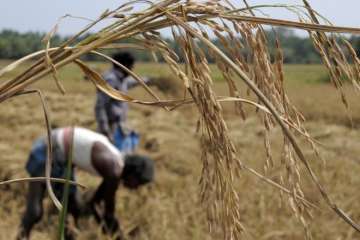Rains ahead of the southwest monsoon across the northern states of Punjab and Haryana, known as the "granaries of India", remained over 50 per cent deficient in the past one month, hampering sowing of paddy in several areas, officials said on Monday.
"The overall deficiency of rainfall in June in Punjab was 50 per cent, while in Haryana it was more than 60 per cent," an Indian Meteorological Department official said.
As per the the Punjab Agriculture Department, the state has completed 52 per cent sowing of kharif season crops, which is 20 per cent more compared to the last season.
This is mainly due to more than 15 lakh tubewells in Punjab and sufficient availability of canal water, mainly in Malwa region.
Haryana, too, has seen a similar trend and recorded nearly 50 per cent sowing of kharif season crops.
Facing water crisis and falling groundwater, Haryana this year has started a pilot project to discourage the water-guzzling paddy crop.
A pilot project was launched in seven blocks of Yamunanagar, Ambala, Karnal, Kurukshetra, Kaithal, Jind and Sonipat districts, where sowing of maize and 'tur' pulses were promoted by giving incentives to farmers.
Water depletion has led to 60 dark zones in the state, including 21 critical ones in 10 districts.
Similarly, Punjab also comes in the category of water-stressed states, with 105 of 138 blocks being categorised in the dark zone.
The extraction of underground water in Punjab is 165 per cent as against 149 per cent in 2013, says the Central Ground Water Board Report of 2019.
Underground water recharging in the state is 21.58 billion cubic metres annually, while the gross water withdrawal is 35.78 billion cubic metres.
Expressing concern at the situation, Chief Minister Punjab Chief Minister Amarinder Singh on June 21 announced an all-party meeting would be called soon to evolve a broad consensus to comprehensively address the problem of depletion of groundwater in the state.
He said it was high time that the state tackled the problem for the future generations, otherwise the fertile Punjab would soon be on the verge of becoming a desert.
On the underlying objective of calling the all-party meeting, the Chief Minister said it would provide a healthy platform for all parties to build a political consensus on the critical issue, and any complacency or laxity would cost the state.
The Chief Minister also sought cooperation of all farmers and farmers' organizations.
Narrating his personal experience while he was Agriculture Minister in the state way back in 1985-86, the Chief Minister pointed out the Eradi Commission constituted by the then Central government assessed availability of water in the state at 17.1 MAF which has now reduced to 13.1 MAF in the past 30 years, adding that the climatic changes had reduced the glacier cover, causing a substantial fall in the groundwater level.
Latest India News

